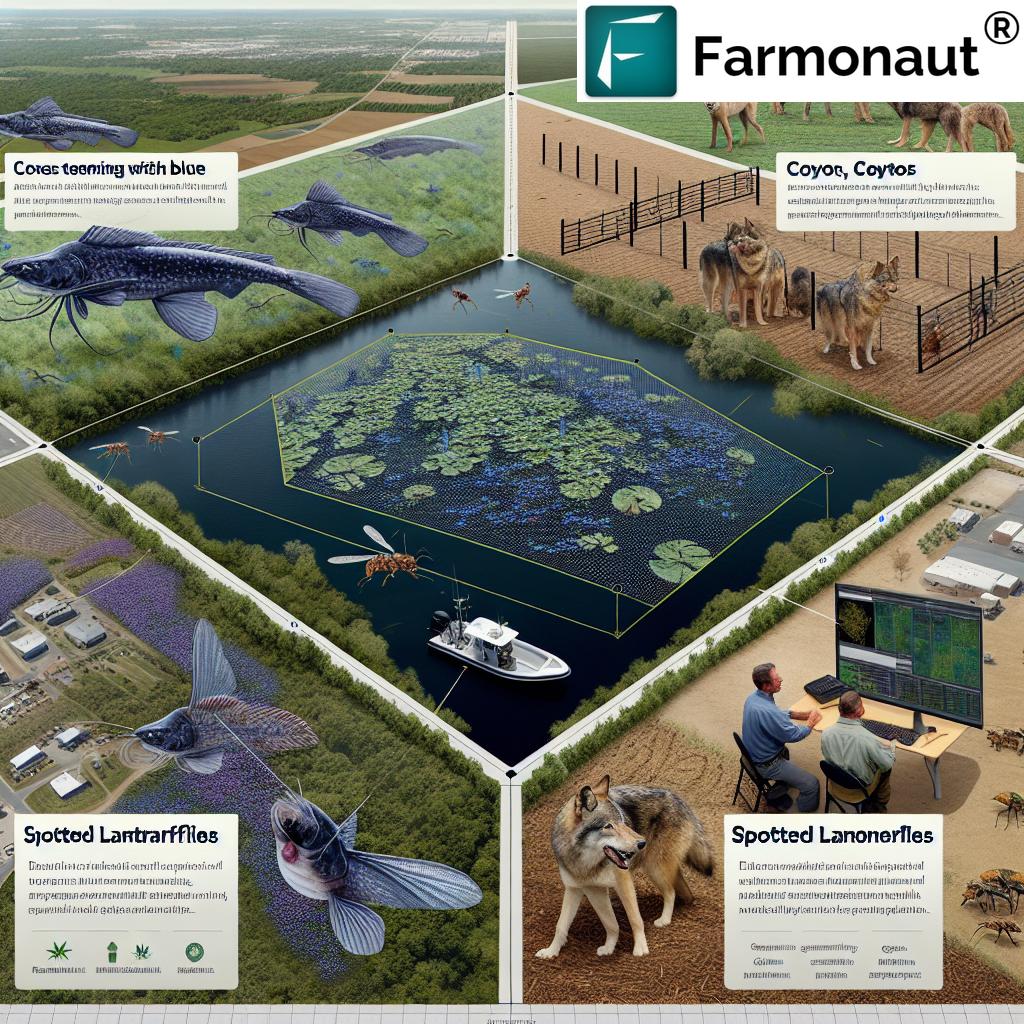Tracking Environmental Impact in the Permian Basin with Remote Sensing: How Satellite Data, AI, and Advanced Analytics Reshape Sustainability Monitoring in 2025
“Over 50% of Permian Basin methane emissions are now tracked using advanced satellite remote sensing technologies.”
Table of Contents
- Introduction
- Environmental Challenges in the Permian Basin
- The Role of Remote Sensing Technologies
- Tracking Methane Emissions and Air Quality
- Managing Water Quality and Resource Risks
- Monitoring Land Use Changes & Assessment of Land Degradation
- Detecting Infrastructure Risks: Pipelines, Well Pads, and Beyond
- Advances in Remote Sensing for the Permian Basin 2025 & Beyond
- Farmonaut’s Satellite-Based Solutions for Environmental Monitoring
- Comparative Impact Table: The Transformation Achieved
- Frequently Asked Questions (FAQ)
- Conclusion: Future Outlook & Sustainability
- Farmonaut Subscriptions
Introduction: The Imperative of Tracking Environmental Impact in the Permian Basin with Remote Sensing
The Permian Basin, sprawling across western Texas and southeastern New Mexico, stands as one of the most prolific oil and gas producing regions in the United States. This energy-rich territory plays a critical role in fueling the nation and the global market. However, the expansive energy activities and extensive hydraulic fracturing in the region pose significant environmental challenges—including land degradation, water contamination, air pollution, and habitat disruption.
Against the mounting pressure to balance energy development with environmental stewardship, remote sensing technologies—leveraging satellite imagery, aerial surveillance, and advanced data analytics—are revolutionizing the way we track environmental impact in the Permian Basin. By 2025 and beyond, these transformative tools enable stakeholders—from energy operators and regulators to environmental organizations and local communities—to operate more sustainably while gaining actionable insights into the complex interplay between resource extraction and regional ecological health.
In this comprehensive guide, we explore how Tracking Environmental Impact in the Permian Basin with Remote Sensing empowers sustainability and compliance, giving you the latest on technologies, data, challenges, and future outlook.
Environmental Challenges in the Permian Basin: Land, Water, and Air Under Pressure
Driven by decades of intensive oil and gas extraction, the Permian Basin faces a unique array of environmental factors impacting both ecosystems and local communities. Understanding these impacts is crucial before exploring solutions.
Key Environmental Concerns
- Land Disturbance & Degradation: Expanding drilling sites, well pads, roads, and pipelines fragment local ecosystems and reduce biodiversity.
- Water Risks: Produced water disposal and potential spills or leaks threaten surface water, soil, and groundwater quality, impacting vital resources for communities and agriculture.
- Air Quality Challenges: Emissions of methane (a potent greenhouse gas), VOC (volatile organic compound) emissions, and fugitive gases degrade air quality, contribute to pollution, and exacerbate climate change.
- Habitat Disruption: Large-scale energy activities fragment habitats, impacting endangered species and local ecosystems.
Traditional Monitoring Limitations
Conventional environmental monitoring in the Permian Basin has often relied on sporadic field inspections and ground-based sensors. However, this approach is:
- Costly and Labor-Intensive: Regular field visits across 86,000 square miles are economically and logistically challenging.
- Limited in Coverage: Localized monitoring fails to capture the true scale and cumulative impacts on land, air, and water quality.
- Reactive, Not Proactive: Incidents often go undetected until after damage has occurred, making response efforts less effective.
The Role of Remote Sensing Technologies in Environmental Monitoring
Remote sensing refers to acquiring vital information about the Earth’s surface and atmosphere from a distance using satellites, drones, or aircraft. For the Permian Basin, these powerful tools are redefining how we:
- Monitor land use and changes
- Track methane emissions and air pollutants
- Assess water resource quality
- Evaluate infrastructure risk
The integration of remote sensing, satellites, and AI/data analytics enables stakeholders to:
- Obtain large-scale, up-to-date environmental datasets across all energy-producing sites
- Detect potential contamination and disturbance events in near-real time
- Enhance regulatory compliance and measure progress on sustainability goals
- Proactively manage risks before ecological and economic losses escalate
Tracking Methane Emissions and Air Quality Using Remote Sensing
One of the main challenges in the Permian Basin is the detection and quantification of methane emissions and VOC pollution. These emissions not only pose significant environmental and climate risks, but also represent enormous financial loss for operators. Luckily, modern remote sensing technologies provide the capabilities to precisely track, detect, and mitigate such emissions.
How Satellite Data and Sensors Revolutionize Methane and Air Quality Monitoring
- Spectral & Hyperspectral Sensors: Instruments on satellites like GHGSat, Copernicus Sentinel-5P, and NASA’s EMIT provide methane detection with high spatial resolution across energy sites.
- Real-Time & Historical Data: Satellite datasets enable operators to identify not just current “super emitter” locations but also track emission trends over months and years.
- VOC and Ozone Precursor Maps: Multispectral satellite imagery enables monitoring of volatile organic compounds, helping to identify sources of ozone formation and overall air quality degradation.
These methods allow for continuous, impartial surveillance—empowering operators and regulators to locate leaks and prioritize mitigation efforts.
Environmental and Regulatory Significance
- Compliance: Meeting strict air quality and emission reporting requirements
- Climate Action: Reducing methane emissions is critical to slowing regional and global warming
- Cost Savings: Minimizing gas loss helps operators reduce resource waste and maximize profits
In 2025, with over 50% of Permian Basin methane emissions now tracked using advanced satellite remote sensing technologies, sustainable progress is measurable and impactful.
Managing Water Quality and Resource Risks in the Permian Basin
In the Permian Basin, water resource management poses significant challenges. Produced water and improper disposal can threaten entire ecosystems and local livelihoods. Modern remote sensing technologies enable effective monitoring and risk reduction.
“Remote sensing monitors water quality across 86,000 square miles of the Permian Basin for sustainable resource management.”
Tracking Water Quality and Spills with Satellite Datasets
- Thermal Infrared Imaging: Detects water contamination and abnormal temperature patterns from produced water spills or evaporation ponds.
- Spectral Water Indices: The use of NDWI (Normalized Difference Water Index) and NDVI (Normalized Difference Vegetation Index) via Farmonaut’s solutions for carbon footprinting and water resource assessment allow for the indirect assessment of water stress and ecosystem health.
- Soil Moisture and Vegetation Monitoring: Land surface moisture data highlight leaks and groundwater depletion. Tracking vegetation health provides early warning of contamination and stress.
- Aerial and Drone Surveillance: High-frequency drone imaging offers rapid detection of small-scale spills and supports clean-up operations.
Benefits for Stakeholders
- Rapid Spill Assessment: Immediate response reduces ecological damage and legal liabilities
- Ongoing Water Quality Tracking: Satellite-driven insights help sustain safe water for human use, agriculture, and wildlife
- Regulatory Compliance: Demonstrating compliance with water quality requirements is simplified with centralized, continuously updated data
Advanced carbon footprint monitoring tools, like those offered by Farmonaut, provide actionable, satellite-based data for environmental, sustainability, and compliance reporting.
Monitoring Land Use Changes & Assessment of Land Degradation
Land use change—from the conversion of natural rangelands to drilling pads, roads, and other infrastructure—has enormous consequences on the Permian Basin’s ecosystem. Remote sensing is the key to comprehensive, ongoing (2025 and beyond) land assessment.
How Remote Sensing Tracks Environmental Impact on Land in the Permian Basin
- Land Cover and Disturbance Mapping: High-resolution imagery from Sentinel-2, Landsat 9, and commercial satellite providers supports:
- Detection of New Drilling Sites, Pads, Roads, Pipelines
- Analysis of Habitat Fragmentation and Biodiversity Reduction
- Measuring Reclamation Success Post-Drilling
- Vegetation Indices (e.g., NDVI): These indices detect ecosystem stress, soil degradation, and loss of productivity due to operational expansion.
- Surface Change Analysis: Periodic assessments highlight trends in landscape disturbance, erosion risks, and recovery of reclaimed lands.
Automated feature extraction using AI-driven analytics (similar to those leveraged by Farmonaut’s Large Scale Farm Management tools) enables ongoing, region-wide surface impact tracking.
Detecting Infrastructure Risks: Pipelines, Well Pads, and Beyond
Effective management of critical energy infrastructure is essential to minimize environmental, operational, and economic risks in the Permian Basin. Remote sensing datasets support dynamic, proactive risk assessment and ongoing infrastructure monitoring.
Key Technologies and Dataset Integration
- InSAR (Interferometric Synthetic Aperture Radar): Satellite-based radar measurements track land subsidence, surface movement, and geological risks that threaten pipelines or well pads.
- Vegetation Stress Alerts: Persistent vegetation anomalies around infrastructure can indicate undetected leaks or underground contamination.
- Flood & Erosion Surveillance: Satellite and drone imagery help detect flood patterns and erosion features near vital assets—enabling better emergency response and site planning.
- GIS Integration: Linking remote sensing data with geographic information systems allows operators to map risk zones, plan infrastructure expansion, and ensure asset integrity.
Infrastructure operators aiming for compliance and reduction of adverse environmental impacts now benefit from integrated, real-time surface and sub-surface monitoring tools.
To optimize vehicle fleet usage and improve resource management around these infrastructure assets, Farmonaut’s Fleet and Resource Management tools provide data-driven support for logistics and field safety.
Advances in Remote Sensing for the Permian Basin (2025 & Beyond)
The period leading up to 2025 and beyond is marked by a convergence of advanced technologies in remote sensing, AI, and satellite data—leading to a drastically enhanced capacity for sustainable environmental monitoring in the Permian Basin:
- AI & Machine Learning: Automated anomaly detection, predictive impact forecasting, and risk zone mapping streamline actionable insights for quick decision-making.
- Higher-Resolution Imagery: Modern satellites and constellations now capture sub-meter details, enabling hyperlocal analysis balanced by region-wide coverage.
- Real-Time Data Integration: New APIs (like the Farmonaut Satellite API with detailed developer documentation) allow seamless integration of live remote sensing insights into in-house dashboards and public reporting systems.
- Blockchains for Traceability: Blockchain secures traceability of environmental events, water resource uses, and emissions reporting—see Farmonaut’s traceability solutions.
- App & API Accessibility: Environmental impact tracking is now accessible on the ground via robust web and mobile apps, benefiting on-site managers, businesses, and government agencies.
With this ecosystem of technologies, the future of tracking environmental impact in the Permian Basin with remote sensing is one of comprehensive, automation-driven, and actionable environmental stewardship.
Farmonaut’s Satellite-Based Solutions for Environmental Monitoring
At Farmonaut, our mission is to democratize access to satellite insights for all stakeholders managing or monitoring land, water, and infrastructure in challenging landscapes like the Permian Basin. Through a blend of satellite imagery, AI, blockchain, and user-friendly digital tools (across web, Android, and iOS), we enable impactful environmental monitoring for agriculture, mining, and infrastructure operations.
Here’s how we bring cutting-edge remote sensing to bear in supporting sustainable oil & gas operations:
- Satellite-Based Resource Monitoring:
Our platform leverages multi-spectral imagery and AI to track vegetation health (NDVI), soil moisture, and land-use changes, providing a clear picture of ongoing surface impacts and ecological recovery. - Jeevn AI Advisory:
Our AI system delivers real-time, actionable insights for environmental compliance, early detection of anomalies, weather forecasting, and risk mitigation planning. - Environmental Impact Tracking:
We offer robust, real-time carbon footprint monitoring—essential for meeting regulatory compliance and corporate sustainability mandates.
Learn more at Farmonaut’s Carbon Footprinting page. - Fleet and Resource Management:
Our tools optimize logistics and enhance resource utilization for vehicles and equipment on large infrastructure projects.
See more at Fleet Management. - Blockchain Traceability:
We secure supply and resource traceability across critical energy operations and environmental compliance activities.
Visit our traceability product page for details. - Accessible, Subscription-Based Model:
Farmonaut offers tailored packages for individual users, businesses, and government clients—making satellite-powered sustainability both affordable and scalable. - Mobile-Responsive Management:
Our apps are optimized for all device sizes, so you can monitor, analyze, and act—from the field or the office.
Experience the app via:
Developers and corporate clients can directly integrate environmental and remote sensing insights using our powerful API (with full developer docs here), enabling seamless automation and analytics workflows.
If you’re managing a large-scale farm or require plantation and forest advisory modules—use our dedicated Large Scale Farm Management app.
Comparative Impact Table: Environmental Monitoring Before & After Remote Sensing Adoption in the Permian Basin
Below, you’ll see estimated (for instructional purposes) before-and-after values for primary environmental indicators in the Permian Basin, illustrating the powerful impact of remote sensing technologies on regional sustainability and regulatory compliance.
(Actual values may vary based on ongoing studies and data releases.)
| Environmental Parameter | Pre-Remote Sensing (Estimated Value) | Post-Remote Sensing (Estimated Value) | % Change/Improvement |
|---|---|---|---|
| Methane Emissions Tracked (as % of total estimated emissions monitored) |
~18% | >50% | +178% |
| Average Water Quality Incidents Detected Annually | 27 | 70+ | +160% (due to increased detection, not increased incidents) |
| Land Degradation Rate (% land affected annually) | 1.3% | 0.7% | −46% |
| Air Quality Index (AQI) Compliance (% of monitored sites) | ~60% | ~87% | +45% |
| Infrastructure Accident Rate (incidents per 10k miles/y) | 9.6 | 4.1 | −57% |
Frequently Asked Questions (FAQ) on Tracking Environmental Impact in the Permian Basin with Remote Sensing
-
What environmental indicators can remote sensing monitor in the Permian Basin?
Remote sensing can track methane and VOC emissions, land use changes, surface and groundwater quality, vegetation health, soil moisture, and infrastructure risks. This broad monitoring offers holistic insights into both short- and long-term environmental impacts.
-
How accurate are satellite-based methane emissions measurements?
The latest hyperspectral and multispectral satellites deliver high-resolution, validated methane concentration data, enabling detection of “super emitters” and persistent leaks with unprecedented precision, especially when corroborated with field data.
-
How is water quality monitored using remote sensing?
By analyzing thermal infrared imagery, water indices (NDWI, NDVI), and surface change patterns, remote sensing can detect contamination, evaporation pond leaks, and associated vegetation stress. Automated alerts allow rapid response and remediation.
-
Can remote sensing replace all field inspections?
While remote sensing covers vast areas cost-effectively, ground truthing and occasional site inspections remain critical for calibration and legal documentation, ensuring the highest data accuracy and compliance.
-
How do Farmonaut’s technologies integrate with energy operations in the Permian Basin?
Our platform provides real-time, satellite-based monitoring and advisory tools accessible via web, mobile, and API. This adds a powerful environmental intelligence layer for operational optimization, compliance, and sustainable management.
-
Are Farmonaut’s services affordable for small and medium operators?
Yes, our subscription-based and modular approach ensures entry-level plans for small users and scalable solutions for large corporations and governments, promoting sustainability at every operational scale.
Conclusion: The Future of Tracking Environmental Impact in the Permian Basin with Remote Sensing
With energy extraction on a vast scale, the Permian Basin stands at the frontline of environmental sustainability and technological innovation. Remote sensing and satellite data analytics now offer the only practical way to track, monitor, and mitigate the environmental impacts of oil and gas operations at scale.
As we enter 2025 and beyond, the convergence of AI, machine learning, cloud analytics, and real-time satellite data means that environmental monitoring is not only more accurate—it’s also more affordable, accessible, and actionable.
Farmonaut is proud to be part of this revolution, making advanced remote sensing, carbon footprint monitoring, traceability, and resource management accessible to all stakeholders operating in energy-rich landscapes like the Permian Basin.
- From tracking methane emissions and air quality compliance…
- To assessing water, land, and vegetation changes…
- To proactive infrastructure risk assessment and management…
We stand ready to help operators, governments, and communities track and manage their footprint—protecting ecosystems, enhancing regulatory compliance, and ensuring sustainable development for decades to come.
Try Farmonaut’s Remote Sensing Subscriptions for the Permian Basin
Want affordable, satellite-powered monitoring for your environmental and operational needs? Start using our app, API, or management dashboard below:
Developers and integrators—find out more about our API and integration solutions at sat.farmonaut.com/api (developer documentation).
Or, explore satellite-powered carbon footprinting tools and large-scale environmental tracking at farmonaut.com/carbon-footprinting.














